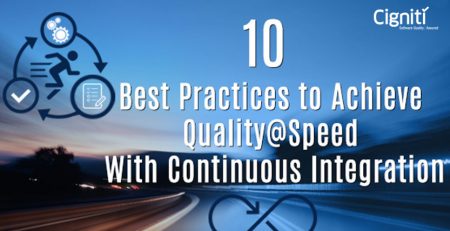Best Practices and Business Benefits of DevOps Transformation
Every enterprise in today’s competitive environment is undergoing digital transformation.
Businesses are attempting to improve their present IT infrastructure and techniques while welcoming new technologies and software development approaches to stay ahead of the competition.
Enterprises’ ability to achieve all of this is highly dependent on their willingness to implement best practices for a successful DevOps transformation.
Businesses that adopt DevOps can provide higher-quality releases with fewer performance concerns.
Because every company’s path is distinct, this transformation should be based on rigorous research into the organization’s cultural basis on which it is constructed.
To take this step, apply the DevOps best practices listed below for a successful DevOps transformation.
Best Practices for a Successful DevOps Transformation
Understanding its culture and fundamental practices is critical to completing a DevOps transformation and ensuring a successful DevOps journey.
To accomplish the intended objectives, DevOps transformation, like any other process, requires a step-by-step strategy.
- Determining and resolving your company’s infrastructure requirements
It’s critical to have a thorough understanding of your current corporate policies. It contributes to the infrastructure and strategic planning of an enterprise. To successfully execute DevOps, you’ll need dependable and automated CI/CD pipelines. Your DevOps teams can use Continuous Integration and Continuous Delivery processes to build a product in short, frequent phases, allowing them to assess and fix issues before deploying the changes to production.
- Create a strategy for transformation.
It is vital to have a well-established plan before beginning a DevOps transformation. Understanding a company’s desire for growth and development is critical. Business objectives, not fear of missing out, should drive your DevOps transformation strategy. We must discover the elements that affect the entire system to achieve optimization and change support. The roadmap should cover all aspects of the transformation process and serve as a guide for teams as they progress. It’s critical at this point to make sure that the transformation’s goals and objectives are communicated throughout the business; teams should have faith in management’s support and transparency as they tackle the challenges ahead. The capacity to gain individual trust is critical to the DevOps transformation process’ success.
- Creating a capable team
It is critical to assess available resources before introducing a new technology or process. A willingness to enhance one’s knowledge base is one of the most important attributes a resource should have. Whatever company model you choose, make sure your team members are motivated to develop new abilities. They should be familiar with the most recent DevOps tools on the market and be prepared to switch if a new one is identified. When dealing with complicated scenarios, your DevOps teams must also be able to think creatively and have the patience to troubleshoot and debug a problem as many times as necessary to find the root cause.
- Choosing the right tools
It’s easier than ever to design, test, and deploy applications with today’s variety of top-notch DevOps technologies. However, given their quick growth, it’s easy to become bewildered. It’s critical to select the correct tools that are compatible with your IT architecture to ensure a smooth DevOps shift. This will enable you to create a solid architecture with customized workflows and access controls that will enhance the user experience and performance.
- Improving test automation and QA coordination
Test automation shortens test cycles, improves quality, and expands test coverage. This isn’t to say you must automate every process. Before automating it, determine the number of iterations a test will require. You’ll be able to tell whether the effort required to automate a test is beneficial or not in this manner. The QA and development teams must be in sync to tackle post-launch issues. Because of this alignment, it’s easier to discover faults early and fix them before the next release.
- Establish defined short-term objectives
Begin your DevOps transformation with simpler, easier-to-implement tasks that can be deployed quickly. By carefully selecting your first project, you will be able to reach a larger audience. Using web-enabled agile applications as a first step in deploying DevOps is a common option. These apps were created with a lean or agile approach that supports DevOps. Don’t plan more than three months ahead of time for the best results. This method has the advantage of allowing you to plan with long-term focus and flexibility.
- Containerized application development
Containerization is a time-saving and safe solution for your development teams to create and deliver software applications. Containers use well-known tools like Dockers and Kubernetes to separate an executable file from other processes. They provide a platform for tracing an application from development to testing to production deployment, encompassing code, dependencies, binaries, libraries, and other components required by your software. Microservice designs, in which your app is separated into several microservices, are better suited to containers than monolithic systems. Microservices provide maximum scalability, agility, automated testing, and rapid deployment for your DevOps team.
- Using CI/CD tools to automate infrastructure
Businesses can respond to changing client requirements and ensure the quality of application modifications with the help of automated CI/CD. To handle configuration management and deployment difficulties, infrastructure automation systems such as Kubernetes, Ansible, Chef, or Puppet can be related to CI/CD solutions such as Jenkins, Bamboo, or GoCD. Through constant monitoring and rolling software upgrades, these technologies enable containers to be risk-tolerant.
- Create workflows and encourage collaboration.
From the commencement of the project’s requirements specification to the creation, testing, and deployment of the final product, the entire team should be involved. Working as a group reduces the chances of making mistakes and failing. We can better handle current difficulties and expedite the DevOps transformation by leveraging team knowledge. Make workflows and assign them to individuals in your team. Regular check-ins will help you keep track of your progress. Use visual clues to assist your DevOps team in navigating and understanding your roadmap. This enhances team communication and data accessibility, allowing development and deployment to be completed more quickly.
- Monitor and assess performance indicators.
Speed, quality, and business agility are the primary goals of the DevOps transformation. Metrics that are aligned with essential company goals and Key Performance Indicators (KPIs) must be collected, analyzed, and measured by teams. Lead Time for Changes (LT), Deployment Frequency (DF), Change Failure Rate (CFR), and Mean Time to Repair (MTTR) — DORA Metrics – are used to assess overall DevOps performance. By providing visibility and predictability over the software development process, these metrics assist DevOps teams in identifying their performance and areas for ongoing improvement.
- Evaluate the effectiveness of your DevOps strategy.
A well-thought-out DevOps transformation roadmap holds a lot of promise. Keep an eye on your team’s progress to ensure that they’re on the right track. Look for strategies to guarantee that all your development and operational teams are aligned with the high-level goals while reviewing the performance of your roadmap.
- Find a technology or implementation partner.
The DevOps transformation, like any other technology adoption, necessitates a well-thought-out plan and the selection of tools that interact seamlessly with the present tech stack as well as future requirements. If you’re new to DevOps or don’t want to take a chance with your resources and projected results, it’s always a good idea to hire a technical partner, especially someone who has already completed many DevOps transformations.
Any enterprise that wants to stay ahead of the competition needs to have an effective DevOps program. The above-mentioned list of best practices should be chosen depending on the organization’s structure, the level of automation involved, project volume, and team collaboration and communication.
DevOps has opened the path for speedier software development and deployment while ensuring 100 percent customer satisfaction by seamlessly integrating Development and Operations teams. The DevOps culture has changed how IT works by bringing teams together to achieve essential business goals.
The Business Benefits of DevOps Transformation
DevOps improves office collaboration and communication, which benefits the business. The better employees work together, the more they interact and collaborate. This promotes employee morale and improves employee camaraderie, making it one of the most effective team management tactics.
Some of the key business benefits of the DevOps transformation include:
- Digital connectivity
- Effective communication
- Increased efficiency
- Improved team collaboration within the team
- Streamlined IT
- Transformation of the culture
- Reduced Time to Market
- Efficient resource allocation
Even though DevOps adoption and implementation appear to be simple, implementing DevOps at scale remains a difficult task for many enterprises.
The fact that the DevOps journey is purely technical is something that many businesses misunderstand. Contrary to popular belief, proper DevOps implementation involves more than just technology.
Processes and platforms, tools and technology, governance and metrics, people and culture, and management are all part of the DevOps journey. This is where Cigniti’s expertise emerges.
Conclusion
Automation and continual improvement are at the heart of DevOps. The key to DevOps transformation is that it is a constant evolution rather than a final state. It’s a path toward a more regular and dependable release pipeline, as well as automation and better communication across development, IT, and business teams.
The DevOps Maturity Model, developed by Cigniti, is a systematic framework for evaluating team and organizational DevOps skills for developing next-generation software.
Many of the industry’s main testing tool suppliers, including Tricentis, enov8, HP, Kiuwan, Digital.ai, ElectricCloud, and others, have formed strategic partnerships with Cigniti. Utilize our strategic agreements with a variety of tool providers to achieve the following goals:
- Software test automation services that are top-of-the-line ensuring that testing is ongoing
- Applications are being released into production at a faster rate.
- Maintain a culture of continual feedback and improvement throughout the software development lifecycle.
- With the correct mix of commercial and open source tools, a collaborative development and continuous testing environment can be created.
Cigniti offers comprehensive DevOps services and expertise to put your DevOps transformation to work, automating at every stage of development and deployment with quality and security embedded into product development and delivery cycles.
Need help? Consult our DevOps Transformation experts to learn more about the best practices and business benefits of DevOps transformation.





Leave a Reply